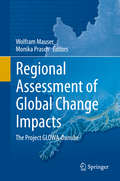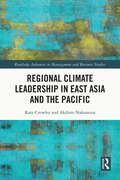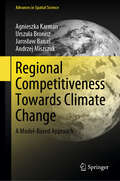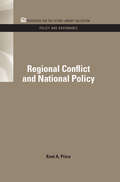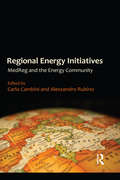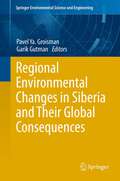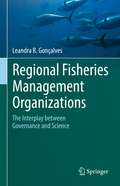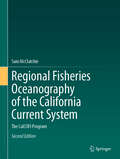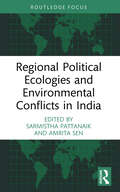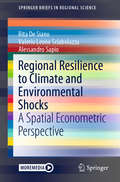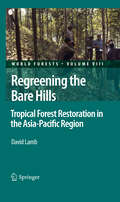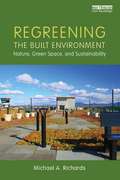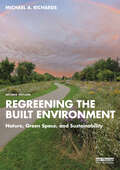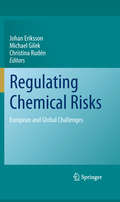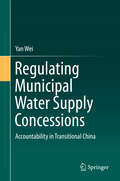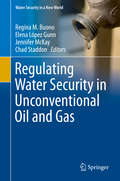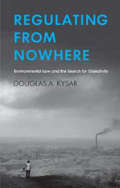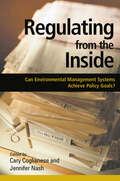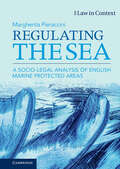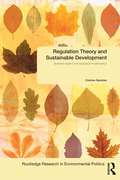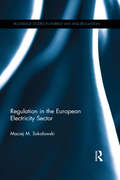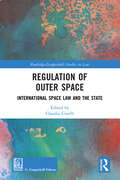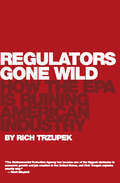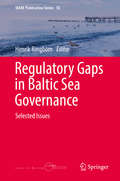- Table View
- List View
Regional Assessment of Global Change Impacts
by Wolfram Mauser Monika PraschThis book provides an overview of the GLOWA-Danube research project from 2001 to 2011, a transdisciplinary initiative which explores the future of water resources in the Upper Danube Basin. It documents the purpose and unique approach, architecture, methodologies, scenarios and results of the project, creating a scientific knowledge base for the dialogue of stakeholders and scientists. The book offers a possible blueprint for successful global change science through integrative and transdisciplinary co-creation of knowledge and orientation for regional adaptation within the context of the Future Earth research program.
Regional Climate Leadership in East Asia and the Pacific (Routledge Advances in Management and Business Studies)
by Kate Crowley Akihiro NakamuraThis book defines regional climate leadership in East Asia and the Pacific as a novel addition to the climate leadership theory. It develops criteria for measuring such leadership on a country basis and uses these for assessing the efforts of developed, lesser-developed, and developing countries within these regions.The book suggests that regional climate leadership consists of leading domestic actions, leading actions within the region, leading actions that are regionally coordinated, and leading actions on a differentiated basis between countries with greater and lesser capacity, and with neighbourly intent. The book is policy and climate solutions-focused, and identifies opportunities for lesson learning and policy transfer for more effective mitigation and adaptation. These solutions take into account the widely varying and complex geographical, political, and institutional circumstances of the region.It is intended for a broad readership of climate policy actors, including policy professionals, academics, non-government researchers, and all who are looking for climate leadership solutions to the problems of accelerating climate impact in East Asia and the Pacific.
Regional Competitiveness Towards Climate Change: A Model-Based Approach (Advances in Spatial Science)
by Andrzej Miszczuk Agnieszka Karman Urszula Bronisz Jarosław BanaśThis book analyzes the competitiveness of European regions and presents forecasts for 2030 and 2100 under different climate scenarios. It examines the economic impact of climate change from a regional economic perspective and sheds light on various factors that influence regional competitiveness and development. Furthermore, the authors derive reflections on EU climate policy and policy recommendations from the empirical results, which will help both scientists and regional decision-makers to implement policy measures and develop successful adaptation processes for the regions and countries of the EU to climate change.
Regional Conflict and National Policy: Regional Conflict And National Policy (RFF Policy and Governance Set)
by Kent A. PriceFirst Published in 2011. Routledge is an imprint of Taylor & Francis, an informa company.
Regional Energy Initiatives: MedReg and the Energy Community
by Carlo Cambini Alessandro RubinoThis book focuses on the two intra-regional initiatives created for the development and integration of energy markets: the Energy Community and MedReg. The Energy Community and MedReg, apart from their common strategic role in providing a much-needed stable regulatory environment for energy markets in their respective reference countries, represent examples of a diverse development of regional energy initiatives. The former is initiated by external factors and is an example of a top-down approach, whereas the latter is a voluntary bottom-up initiative of the countries involved. The way the institutional framework is built is not without consequences on the functioning and organization of the two regional initiatives. The book assesses these different approaches and their consequences in the framework of the development of the Energy Community and MedReg, with particular reference to their impact on regional integration, energy policy and institutional change. The analysis is enriched with several case studies on the role of independent regulatory agencies, the promotion of renewable energy sources, infrastructure and interconnection development across the Mediterranean basin and the implications of exporting the EU institutional model. This book is aimed at policy makers, institutions, energy companies and academics to provide a better understanding of the economic and institutional eco-system that characterize the Mediterranean area.
Regional Environmental Changes in Siberia and Their Global Consequences
by Garik Gutman Pavel Ya. GroismanThis volume presents a state-of-the-art assessment of the Earth's climate system in Siberia and relationships between climate, ecosystems and people in that region. Changes in climatic variables and land cover in Siberia are among the earliest indicators of the Earth's response to climate warming. The volume is a compilation of results from studies on climate, land-cover and land-use changes and their interactions with biogeochemical and water cycles, atmospheric aerosol, and human and wildlife populations in Siberia. Regional changes in Siberia are predicted to affect climate and people on a global scale. NASA, the Russian Academy of Sciences, and several European institutions have supported these studies. The primary supporter of the projects that produced the results compiled in this volume is the NASA Land-Cover/Land-Use Change Program, hence most studies use remote sensing in their research. The chapters in this volume were written by an international team of scientists from the USA, Europe and Russia under the auspices of the Northern Eurasia Earth Science Partnership Initiative (NEESPI). This book will be of interest to those involved in studying recent and ongoing changes in Siberia, be they senior scientists, early career scientists or students.
Regional Fisheries Management Organizations: The interplay between governance and science
by Leandra R. GonçalvesThis book analyzes empirical data from three specific Regional Fisheries Management Organizations (RFMOs) designed to establish rules for the conservation and management of fish stocks in the ocean, in order to assess their effectiveness in converting science into policy for the recovery and maintenance of fishery populations. The three RFMOs discussed are the CCAMLR (Convention for the Conservation of Antarctic Marine Living Resources), the ICCAT (International Commission for the Conservation of Atlantic Tunas) and the CCSBT (Commission for the Conservation of Southern Bluefin Tuna). The book seeks to understand when governments choose to listen to science, and establishes a framework to examine the institutional designs currently in place to accommodate RFMO policy suggestions and the conditions under which they are implemented successfully. The study will be of interest to academics and professionals broadly interested in global environmental governance and international relations, and will specifically appeal to policymakers, conservationists, and environmental researchers interested in fishery management and policy at the global and regional scale. Gonçalves provides an accessible and comprehensive analysis of RMFOs. She offers valuable insights into the role of science and politics in shaping sustainable fisheries policies for the open oceans. ---Peter M Haas, Professor Department of Political Science, University of Massachusetts AmherstAs envisaged by the UN Decade of Ocean proclamation, this book is an important and sincere effort, hopefully to be accompanied by many others to come during this promising decade, that will help to build a common framework to ensure that ocean science can support countries and the international community in creating improved conditions for the sustainable development of our cherished Ocean.---Fabio H. Hazin - Professor at Federal Rural University of Pernambuco, Brazil
Regional Fisheries Oceanography of the California Current System: The CalCOFI Program
by Sam McClatchieThe California Current System is one of the best studied ocean regions of the world, and the level of oceanographic information available is perhaps only surpassed by the northeast and northwest Atlantic. The current literature (later than 1993) offers no comprehensive, integrated review of the regional fisheries oceanography of the California Current System. This volume summarizes information of more than 60-year California Cooperative Oceanic Fisheries Investigation (CalCOFI). While providing a large bibliography, the intent was to extract themes relevant to current research rather than to prepare a compendious review of the literature. The work presents a useful review and reference point for multidisciplinary fisheries scientists and biological oceanographers new to working in the California Current System, and to specialists wishing to access information outside their core areas of expertise. In addition, the first editioin published in 2014 aimed to deliver an up to date reference to the current state of knowledge of fisheries oceanography in the California Current System. The second edition adds some new sections, and data visualizations. The most important new material is included in the perspectives on CalCOFI chapter. New vignettes have been added for Reuben Lasker, Ed Brinton, Abraham Fleminger, Elizabeth Venrick, and Andrew Leising. The vignette for Noelle Bowlin has been updated to reflect her position as the current NOAA lead for the CalCOFI program, and a vignette has also been added for Sam McClatchie.
Regional Political Ecologies and Environmental Conflicts in India (Routledge Focus on Environment and Sustainability)
by Sarmistha Pattanaik and Amrita SenThis book focuses on the regional political ecologies (RPEs) of environmental conflicts in India. It explores broadly, landscape-based analyses of political, economic and social issues, which impact environmental changes, challenges and conflicts at local and micro-local levels. The chapters in this volume examine the intervention of different stakeholders in the management of various regional ecological landscapes in India, including forests, rivers, canals, creeks and wetlands. The volume is an interdisciplinary endeavour, weaving together contextual narratives through a combination of approaches from sociology, anthropology, geography, political studies and environmental history. Using such core approaches, the book studies the place-based dynamisms within the regional environmental conflicts in the selected conservation landscapes. It provides empirical reflections on transboundary issues, rural-urban transitions, middle-class environmentalism, identity conflicts, decentralized natural resource management and the role of political institutions. Regional Political Ecologies and Environmental Conflicts in India will be of great interest to students and scholars of Political Ecology and South Asian Environmental Studies.
Regional Resilience to Climate and Environmental Shocks: A Spatial Econometric Perspective (SpringerBriefs in Regional Science)
by Rita De Siano Valerio Leone Sciabolazza Alessandro SapioThe book illustrates the use of spatial econometric models to analyze the economic resilience of regions to climate-related shocks. Although climate change is a global externality, climate anomalies can trigger locally disruptive shocks, whose adverse effects on economic growth are transmitted through neighbouring relationships (based on geography, trade, or technological bonds). After laying out the theoretical case for spatial analysis in the study of economic resilience, the book introduces spatial econometric models, their estimation and testing procedures, as well as applications of spatial econometrics in various domains. It then reviews the current literature on the role of space in the propagation of climate shocks, and discusses how adaptation and mitigation policies can leverage spatial dependencies, with a special focus on renewable energy technologies and agricultural productivity. It appeals to scholars of regional and spatial sciences and econometrics as well as those interested in the spatial effects of climate and environmental shocks.
Regreening the Bare Hills
by David LambIn Regreening the Bare Hills: Tropical Forest Restoration in the Asia-Pacific Region, David Lamb explores how reforestation might be carried out both to conserve biological diversity and to improve the livelihoods of the rural poor. While both issues have attracted considerable attention in recent years, this book takes a significant step, by integrating ecological and silvicultural knowledge within the context of the social and economic issues that can determine the success or failure of tropical forest landscape restoration. Describing new approaches to the reforestation of degraded lands in the Asia-Pacific tropics, the book reviews current approaches to reforestation throughout the region, paying particular attention to those which incorporate native species - including in multi-species plantations. It presents case studies from across the Asia-Pacific region and discusses how the silvicultural methods needed to manage these 'new' plantations will differ from conventional methods. It also explores how reforestation might be made more attractive to smallholders and how trade-offs between production and conservation are most easily made at a landscape scale. The book concludes with a discussion of how future forest restoration may be affected by some current ecological and socio-economic trends now underway. The book represents a valuable resource for reforestation managers and policy makers wishing to promote these new silvicultural approaches, as well as for conservationists, development experts and researchers with an interest in forest restoration. Combining a theoretical-research perspective with practical aspects of restoration, the book will be equally valuable to practitioners and academics, while the lessons drawn from these discussions will have relevance elsewhere throughout the tropics.
Regreening the Built Environment: Nature, Green Space, and Sustainability
by Michael A RichardsRegreening the Built Environment examines the relationship between the built environment and nature and demonstrates how rethinking the role and design of infrastructure can environmentally, economically, and socially sustain the earth. In the past, infrastructure and green or park spaces have been regarded as two opposing factors and placed in conflict with one another through irresponsible patterns of development. This book attempts to change this paradigm and create a new notion that greenspace, parks, and infrastructure can indeed be one in the same. The case studies will demonstrate how existing "gray" infrastructure can be retrofitted with green infrastructure and low impact development techniques. It is quite plausible that a building can be designed that actually creates greenspace or generates energy; likewise, a roadway can be a park, an alley can be a wildlife corridor, and a parking surface can be a garden. In addition to examining sustainability in the near future, the book also explores such alternatives in the distant and very distant future, questioning the notion of sustainability in the event of an earth-altering, cataclysmic disaster. The strategies presented in this book aim to stimulate discussions within the design profession and will be of great interest to students and practitioners of environmental studies, architecture, and urban design.
Regreening the Built Environment: Nature, Green Space, and Sustainability
by Michael A. RichardsNow in its second volume, Regreening the Built Environment provides an overview of physical and social environmental challenges that the planet is facing and presents solutions that restore ecological processes, reclaim open space, foster social equity, and facilitate a green economy.Healing the planet requires a combination of strategies networked across multiple scales of development, including buildings, sites, communities, and regions. Case studies from a range of locations in the United States, Denmark, Vietnam, Germany, South Korea, Switzerland, France, and the United Kingdom, among others, demonstrate how existing gray infrastructure can be retrofitted with green infrastructure and low-impact development techniques. From this, the author shows how a building can be designed that creates greenspace or generates energy; likewise, a roadway can be a parkway, an alley can be a wildlife corridor, and a parking surface can be a garden. This new edition also includes case studies that have successfully reconnected communities that were fragmented by unjust planning practices and irresponsible patterns of development, resilient design solutions in response to natural disasters, passive design strategies that can make interior spaces more efficient and healthier, and expanded discussions on capturing carbon, renewable energy, agriculture, waste, public transit, and adaptive reuse, including innovative ideas on how to reimagine the shopping mall in the era of e-commerce.The strategies presented in this book will stimulate discussions within the design profession and will be of great interest to students and practitioners of environmental studies, architecture, landscape architecture, and urban design.
Regulating Chemical Risks
by Michael Gilek Christina Rudén Johan ErikssonThis important contribution to the scientific understanding of chemical risk regulation offers a coherent, comprehensive and updated multidisciplinary analysis, written by leading experts in toxicology, ecotoxicology, risk analysis, media and communication, law, and political science.
Regulating Municipal Water Supply Concessions
by Yan WeiThis book discusses the recently introduced concession policy, which is also known as PPP worldwide, on municipal utilities policy in China. In this context, critics have claimed that there is a gap in accountability with regard to concessions. The author utilizes interdisciplinary methods and comparative studies, taking into account the situation in the EU and US to analyze the accountability gap some feel will be created when the policy is implemented. Taking water sector concessions as the subject of discussion, the author distinguishes between three types of accountability: traditional bureaucratic accountability, legal accountability and public accountability. By systematically analyzing the essential problems involved, the book attempts to achieve a better understanding of concession and its application in the context of public utilities and finds that the alleged accountability gap is attributed to traditional bureaucratic accountability in China and the concession system per se.
Regulating Water Security in Unconventional Oil and Gas (Water Security in a New World)
by Chad Staddon Regina M. Buono Elena López Gunn Jennifer McKayThis book addresses the need for deeper understanding of regulatory and policy regimes around the world in relation to the use of water for the production of ‘unconventional’ hydrocarbons, including shale gas, coal bed methane and tight oil, through hydraulic fracturing. Legal, policy, political and regulatory issues surrounding the use of water for hydraulic fracturing are present at every stage of operations. Operators and regulators must understand the legal, political and hydrological contexts of their surroundings, procure water for use in the fracturing and extraction processes, gain community cooperation or confront social resistance around water, collect flow back and produced water, and dispose of these wastewaters safely. By analysing and comparing different approaches to these issues from around the globe, this volume gleans insights into how policy, best practices and regulation may be developed to advance the interests of all stakeholders. While it is not always possible to easily transfer ‘good practice’ from one place to another, there is value in examining and understanding the components of different legal and regulatory regimes, as these may assist in the development of better regulatory law and policy for the rapidly growing unconventional energy sector.The book takes an interdisciplinary approach and includes chapters looking at water-energy nexus security in general, along with issue-focused and geographically-focused case studies written by scholars from around the world.Chapter topics, organized in conjunction with the stage of the shale gas production process upon which they touch, include the implications of hydraulic fracturing for agriculture, municipalities, and other stakeholders competing for water supplies; public opinion regarding use of water for hydraulic fracturing; potential conflicts between hydraulic fracturing and water as a human right; prevention of induced seismic activity, and the disposal or recycling of produced water. Several chapters also discuss implications of unconventional energy production for indigenous communities, particularly as regards sustainable water management. This volume will be of interest to scholars and students of energy and water, regulators and policymakers and operators interested in ensuring that they align with emergent best global practice.
Regulating from Nowhere: Environmental Law and the Search for Objectivity
by Douglas A. KysarDrawing insight from a diverse array of sources -- including moral philosophy, political theory, cognitive psychology, ecology, and science and technology studies -- Douglas Kysar offers a new theoretical basis for understanding environmental law and policy. He exposes a critical flaw in the dominant policy paradigm of risk assessment and cost-benefit analysis, which asks policymakers to, in essence, "regulate from nowhere. " As Kysar shows, such an objectivist stance fails to adequately motivate ethical engagement with the most pressing and challenging aspects of environmental law and policy, which concern how we relate to future generations, foreign nations, and other forms of life. Indeed, world governments struggle to address climate change and other pressing environmental issues in large part because dominant methods of policy analysis obscure the central reasons for acting to ensure environmental sustainability. To compensate for these shortcomings, Kysar first offers a novel defense of the precautionary principle and other commonly misunderstood features of environmental law and policy. He then concludes by advocating a movement toward environmental constitutionalism in which the ability of life to flourish is always regarded as a luxury wecanafford.
Regulating from the Inside: Can Environmental Management Systems Achieve Policy Goals (Rff Press Ser.)
by Cary CoglianeseEnvironmental Management Systems (EMSs) offer an approach to regulatory policy that lies somewhere between free-market and traditional command-and-control methods. Worldwide, hundreds of thousands of private firms have adopted or are considering adopting these internally managed systems for improving environmental performance. In the United States, the Environmental Protection Agency has established a special recognition for firms that adopt EMSs. Already, numerous state agencies have proposed or adopted 'green-tier systems' that allow firms with EMSs to be exempted from otherwise applicable requirements. Yet while private- and public-sector interest in EMSs is booming, limited empirical evidence is available about the efficacy of EMSs. To close the gap between advocacy and analysis, Regulating from the Inside brings together cutting-edge work of leading scholars, providing the most comprehensive analysis to date of environmental management systems. Intended to frame the future policy and the research agenda about EMSs, the discussions are organized around two critical questions: How have EMSs worked in firms that have already adopted them? What potential and limitations do they have as policy tools in the future? Addressing the arguments of both advocates and skeptics, the chapters examine why firms adopt EMSs; how firms implement EMSs; how EMSs answer concerns about fairness, corporate social responsibility, and sustainability; and what kind of impact EMSs may have on the global economy.
Regulating the Sea: A Socio-Legal Analysis of English Marine Protected Areas (Law in Context)
by Margherita PieracciniThis book is the first ever written on English marine conservation regulation from a socio-legal perspective. The monograph presents an in-depth analysis of key aspects of Marine Protected Areas regulation in England, offering the reader access to an under-investigated field. Such regulatory mapping is complemented by an interdisciplinary treatment of the subject exploring the relationship between people and marine parks through central themes in environmental social sciences and regulatory theory, namely space, rationalisation, democracy and adaptation. Thus, the book is of interest to environmental lawyers and regulatory scholars but also to human geographers, environmental sociologists and political scientists. As the book provides critical reflections on current legal and regulatory structures, it contains valuable insights for policymakers and regulators. The book has a strong methodological basis drawing on in-depth desk-based research, complemented by primary qualitative research, conducted over a number of years.
Regulation Theory and Sustainable Development: Business Leaders and Ecological Modernisation (Environmental Politics)
by Corinne GendronThis book argues that current economist theories do not take into account the socially constructed nature of the debate surrounding the environment and environmental policy. It examines whether proposed economic solutions to environmental policy are, in fact, viable in practice. The book demonstrates that social conflicts cause policy compromises, which shape the economic system of a post-industrial ecological society. The author offers an innovative socio-economic theory of environmental politics, which illuminates the transformation dynamics brought about by the ecological crisis. Regulation Theory and Sustainable Development will be of interest to students and scholars of environmental politics, policy and governance.
Regulation in the European Electricity Sector (Routledge Research in Energy Law and Regulation)
by Maciej M SokołowskiSince the very beginning of European integration, electricity has been within the legal sphere of the EU. Much of this is found within the binding European acts making up the framework of the Energy Packages. The established legal institutions have had a significant impact on the shape of the energy market in Europe. Nevertheless, the European energy market still seems to be developing, as demonstrated by the current lively discussion about the state of the Energy Union. Regulation in the European Electricity Sector delves into European energy law and reflects on some of the primary issues related to the public legal impact on the European energy sector. The book offers a brief explanation of the background operation of the electricity sector, as well as liberalisation within the area, and traces the evolution of the EU’s approach towards the issue of public law regulation within the electricity sector. Finally, the book presents an analysis of European and national laws, considering their interpretation, and explores the future of public law regulation. Aimed at giving the reader a deep insight into a nature of the state’s presence in the power sector, this book will be of great interest to students and scholars of EU energy law and policy.
Regulation of Biological Control Agents
by Ralf-Udo EhlersThis book presents a comprehensive compilation of registration requirements necessary for authorisation of biological control agents (viruses, bacteria, fungi, active substances of natural origin and semiochemicals) in OECD countries. It also reviews data requirements for invertebrate agents (insect, mites and nematodes) and provides proposals for harmonisation of the regulation process and guidelines for completion of application forms. Based on results of the EU REBECA Policy Support Action, which gathered experts from academia, regulation authorities and industry, risks and benefits of the specific agents were reviewed and proposals for a more balanced registration process elaborated, including recommendations for acceleration of the authorisation process and discussions on trade-off effects and policy impacts. All these aspects are covered in detail in this book, which points the way forward for enhanced utilisation of biological control agents.
Regulation of Outer Space: International Space Law and the State (Routledge-Giappichelli Studies in Law)
by Marco FerrazzaniThis edited book focuses on how States should regulate activities in space and explores strategies to advance State responsible behaviour to ensure sustainable use and effective protection of outer space for peaceful purposes. The time seems ripe to bring international law into the space sustainability discourse. The concept of sustainable development was conceptualized by the 1987 Brundtland Report, Our Common Future. Today, as then, the overlap between the security, environmental and economic dimensions, including in terms of intra/inter-generational equity, is reflected within the current ‘new space’ era that is now ‘our common future’. This edited book collects original theoretical and empirical contributions. It contributes to unpack the international outer space regulatory framework in the light of current trends and pressing challenges. This offers a unique perspective and guidance thus empowering regulatory strategies for stakeholders and end-users such as scholars, policy-makers, industry and society.
Regulators Gone Wild
by Rich TrzupekRich Trzupek has spent over 25 years engaged in combat with the environmental movement on the front lines, helping America's industrial sector defend itself against the increasingly aggressive tactics that environmental advocacy groups and their allies in the Environmental Protection Agency employ. In Regulators Gone Wild Trzupek lays out the inside story that describes the way the green/big government alliance has combined to stifle American productivity and hamstring American innovation, not by design, but as the inevitable consequence of pursuing a utopian vision of environmental purity that can never, ever be realized.As a respected scientist and consultant, Rich Trzupek has been employed by some of America's largest corporations and by some of its smallest, most innovative entrepreneurs. Those experiences have provided him with a unique perspective. While many of his colleagues in the industrial consulting community only consider the short-term profit opportunities that an overly aggressive EPA provides them, Trzupek takes a longer view. If the EPA continues to hamstring America's ability to create wealth, everyone loses.When it comes to today's environmental issues, most of the public's attention is focused on the issue of "climate change" and initiatives to reduce fossil fuel use and greenhouse gas emissions. As a climate change skeptic, Trzupek argues against these measures, but he sees the rise of this issue as another inevitable step in a progression that spans four decades during which the green movement has continually sought new ways to control industry and the EPA has always happily obliged them. Attempts to restrict America's use of cheap, plentiful coal and stop oil exploration are just the latest examples of regulators gone wild.
Regulatory Gaps in Baltic Sea Governance: Selected Issues (Mare Publication Ser. #18)
by Henrik RingbomThe focus of this publication is the uniqueness of the Baltic Sea from a legal perspective, and the regulatory voids that result from the multiple layers of regulation this area is subjected to: up to six layers of regulation (general international law, regional conventions, EU law, national laws, local and municipal rules plus a whole range of non-binding norms and other 'soft law' arrangements) act in parallel. However, a large number of rules or regulatory layers does not in itself ensure effectiveness or consistency. When the regulatory landscape is approached from the point of view of individual substantive topics, it is apparent that the norms of different regulatory layers entail both overlaps, gaps and uncertainties, differently for each topic. This publication addresses a selection of topics that are decidedly international in nature, but for which current international and EU rules include important gaps or uncertainties.In addition to presenting a set of legal analyses of topical issues for the region, which in itself is a meritorious objective in view of the relative scarcity of legal studies with a focus on the Baltic Sea, the publication also seeks to analyze the regulatory 'anatomy' of the selected issues in more detail. Through the legal analyses the chapters explore how regulatory gaps are formed, how they are filled, how the rules of the different layers work together and interact with each other in the selected areas. Accordingly, the secondary ambition is to explore, through the chapters, whether more general conclusions can be drawn about the nature of the regulatory gaps and multi-layerism in order to produce a better understanding of how regulations on multiple levels operate in practice.
